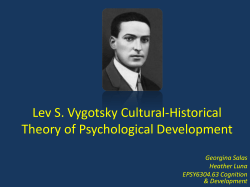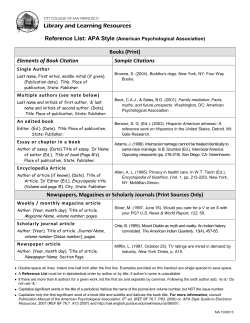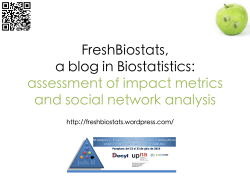
How to be PRESENT in the Virtual Classroom: Increasing Social Presence in
How to be PRESENT in the Virtual Classroom: Increasing Social Presence in Online Courses Jessica Gordon Curriculum Coordinator in the Department of Focused Inquiry Overview of Presentation I: History of research into Social Presence II: Social presence is correlated with student learning and course satisfaction III: Synthesis of published and non-published recommendations for increasing social presence in small to midsize online classes—and my opinions (emoticon intended, and you will see why) IV: Discussion Two Shifts in Beliefs about Social Presence Fields and Disciplines o FROM field of telecommunications o TO applications in education Understanding of User Agency o FROM believing that social presence was defined and limited by the technology o TO believing that users possess the ability to increase social presence in the technology Theory of Social Presence (1976) Short, J., Williams, E. & Christie, B. (1976). The Social Psychology of Telecommuncations. Definition: “degree of salience of the other person in a mediated communication and the consequent salience of their interpersonal interactions”. How “real” a person seems when communicating in a given medium. o Depends on verbal and nonverbal cues o Forms of media vary in their potential for social presence o Some forms of media had a higher potential for social presence (video) than others (written word). Note: Short, Williams and Christie believed social presence was a quality of the medium itself. Theories that Support Social Presence as a Quality of Medium Itself Media Richness: Developed by Ronald Rice (1984, 1986): “Media richness represents the extent to which media are able to bridge different frames of reference, make issues less ambiguous, or provide opportunities for learning in a given time interval, based on the medium’s capacity for immediate feedback, the number of cues and sense involved, personalization and language variety. Redefining Media Richness: Trevino, Lengo and Daft (1987): Expanded Rice’s theory and defined “media richness” as “the potential information sharing capacity of data or simply as the capacity of information to provide substantial new understanding” (p. 178). Like the Theory of Social Presence, these definitions of “media richness” support the belief that social presence is a quality of the medium itself and is not defined by the user. The Community of Inquiry Framework: A Radical Shift in Perception • Signifies a shift toward believing in one’s own ability to influence presence—social, teaching and cognitive • First well-known application to education Garrison, D., Anderson, T., Archer, W. (2000). Critical inquiry in a text-based environment: Computer conferencing in higher education. The Internet and Higher Education, 2(2-3), 87-105 Cognitive Presence: “extent to which participants in any particular configuration of a community of inquiry are able to construct meaning through sustained communication” Teaching Presence: “the design, facilitation, and direction of cognitive and social processes for the purpose of realizing personally meaningful and educationally worthwhile learning outcomes” Social Presence: “the ability of participants in the Community of Inquiry to project their personal characteristics into the community, thereby presenting themselves to the other participants as ‘real people’” 1. What elements are crucial prerequisites for a successful higher education experience? 2. How can we maintain these crucial components when higher education is moved online? Garrison, Anderson and Archer analyzed transcripts of computer conferences in the field of Education and identified indicators of the three types of presence. Indicators included keywords, sensations, connections, applications, forms of expression, etc. Community of Inquiry Framework --cited over 1725 times-Garrison, Anderson, and Archer o Believe that faculty can create a community of inquiry in face-to-face and online classrooms through maintaining high levels of presence—cognitive presence, teaching presence, and social presence. o Some of what we know about presence in face-to-face classes can be applied to the online classroom. Five Studies that Indicate that Student Perception of Social Presence IS Correlated with Student Course Satisfaction Gunawardena and Zittle (1997): Social Presence as a Predictor of Satisfaction within a ComputerMediated Conferencing Environment Richardson and Swan (2003): Examining Social Presence in Online Courses in Relation to Student’s Perceived Learning and Satisfaction M.F. Beaudoin (2002): Learning or Lurking? Tracking the ‘Invisible’ Online Student” Arbaugh and Benbunan-Fich (2007): The Importance of Participant Interaction in Online Environments Saiye Tugba Bulu (2012): Place Presence, Social Presence, Co-presence, and Satisfaction in Virtual Worlds Findings of the Five Studies All of the studies found significant correlations between one or more of the following: o social presence and student learning o social presence and course grades o social presence and student course satisfaction o perceived social presence and perceived learning These studies also illuminated other interesting results which we will discuss in more depth now… Five Ways to Increase Student and Instructor Social Presence in Online Classes: A Synthesis of the Published Literature plus my Own Examples and Opinions I. II. III. IV. V. Maximizing Student Presence through Instructor Modeling of Social Presence Behaviors Teacher Immediacy: Sharing and Encouraging Stories Creating Social Cues: Encouraging Emoticons and Casual Language Optimizing the Learning Platform for Social Presence Virtual Worlds (Second Life) and Social Presence Faculty Must Model Social Presence Behaviors Research indicates: Faculty who teach online college courses must support learners by understanding that their own social presence and social cues are arguably the most important predictors of social presence in the virtual classroom, and faculty must model those social behaviors to their online students. (Jung, Choi, Lim & Leem, 2002; Richardson and Swan, 2003; Shea, Pickett, Pelz, 2002; Swan and Shih, 2005). But HOW Should Faculty Model Social Presence? First, We Should Exhibit Teacher Immediacy Behaviors Teacher immediacy is instructor behavior that enhances “closeness and interaction” and is the “major mechanism mediating teacher effectiveness” (Anderson, 1978). How Do We Create Immediacy in the Classroom? o Consider the Immediacy Behavior Scale o Share Stories and anecdotes (academic and social) How Should Faculty Model Social Presence? The Immediacy Behavior Scale Immediacy Behavior Scale (Verbal & Non-verbal Behaviors) o McCroskey, Richmond, Gorham (1987, 1988) o Scale describes verbal and nonverbal immediacy behaviors in face-to-face classes o Created for face-to-face classroom but verbal behaviors can easily be applied to online environment o Faculty Prize these behaviors in the face-to-face classroom but the struggle to communicate and teach in the online environment can often cause us to overlook the basics. Sample Verbal Questions on Teacher Immediacy Behavior 1. Uses personal examples or talks about experience she/he has had outside of class. 3. Gets into discussions based on something a student brings up even when this doesn’t seem to be part of his/her lecture plan. 10. Refers to class as “our class” or what “we” are doing. 13. Asks how students feel about an assignment, due date or discussion topic. 16. Asks questions that solicit viewpoints or opinions A Second Way That Faculty Can Model Social Presence? Share and Encourage Stories Garrison, Anderson and Archer suggest that “self disclosure is another example of emotional expression contributing to the development of social presence” How natural it is to share stories in the face-to-face classroom, before, after and sometimes during class—and how easy it is to forget to do so when teaching and learning online. When? Where? How? Twitter--Facebook--Google Hangout for Office Hours A Third Way to Increase Social Presence: Creating Social Cues by Encouraging Emoticons, Paralanguage and Casual Speech Although our instinct is to ask students to write in formal, academic language or at the very least, to proofread for typos and use punctuation according to standard usage guidelines, the research suggests that this may actually decrease social presence in online classes. Research suggests that the use of emoticons and paralanguage are positively correlated with social presence (Gunawardena and Zittle (1997); Garrison, Anderson & Archer (2000); Whip and Lorentz (2009); Wei, Chen and Kinshuck (2012); Using Paralanguage and Emoticons Whip and Lorentz (2009) found that teachers with high social presence in online classrooms “exaggerated punctuation or spelling”. Whheeeww! Or Here gooeess… These teachers emphasized words with capital letters and projected emotions by literally spelling them out. I’m excited or Sorry if I sound angry here. They also projected empathy by naming their responses to student feelings: I hear your frustration or That feeling of panic can be productive Remember: In the Community of Inquiry framework, the first category of social presence indicators in the expression of emotion. Using Social Cues to Increase Social Presence Gunawardena and Zittle (1997) found: “students who experienced higher levels of social presence were also more inclined to use emoticons (eg., and ) and paralanguage in written form (eg., ‘Hmm,’ ‘Yuk’) to make up for the lack of social and nonverbal cues that help create social presence and immediacy in traditional face-to-face communication” Using Social Cues to Increase Social Presence Wei, Chen and Kinshuk (2012) echo all these findings and claim that “Verbal and non-verbal cues are very important resources for perceived social presence in online learning environments (p. 539). They explain that “When learners perceive a high degree of social cues from other people, they will get a better perception of social presence” (p. 540). As a writing teacher myself, I was at first resistant… If we encourage the use of emoticons, do we also allow students to use text-based language such as that which they commonly use for texting on the phone? Where do we draw the line? What’s the difference between allowing students to use informal language during discussion in face-to-face classes versus using informal language such as emotions and paralanguage in a discussion board posting? A Fourth Way To Increase Social Presence: Optimizing the Learning Management System What’s wrong with Blackboard? Blackboard is a content management system, not a learning management system. Blackboard was made for the web 1.0 world – Web 1.0 = top down medium for communication – Web 2.0 = bottom up medium for communication AND PARTICIPATION in which users can create and contribute content Can a Content or Learning Management System like Blackboard Impact Social Presence? Wei, Chen and Kinshuk (2012), studied whether user interface and social cues affect learner’s perceived social presence. They found that user interface is an important factor in online learning since social interaction is facilitated through it. They also found that “user interface and social cues have significant influences on social presence. User interface also has significant effects on social cues” (p. 540). Why Does Blackboard Lack Social Presence? In my opinion, one of the biggest problems with Bb is that participants lack identity. How can there be social presence if no one has an identity? Even dictionary entries allow participants to interact and each participant is identified by a photo (if s/he chooses). Meriam Webster definition for “Agency” Everyone Uses Blackboard? Or Do They? Early 2000s: Blackboard used by 70-85% of education institutions In 2011: Blackboard used by over 3700 education institutions in more than 60 countries According to Michael Feldstein (2013), Blackboardowned systems are currently the learning systems of choice at no more than 60% of American institutions. Why the Shift? There are multiple reasons to account for this shift in use in content/learning management systems, but one main reason is competition. – Open Source Learning Platforms: Moodle & Sakai – Free Applications: Blogs, Wikis and Google Sites – Free User-created Social Networking Sites: Ning, Grouply and Social Go Virtual Worlds: Second Life One of the primary reasons that educators are so interested in Second Life is because it appears to substantially increase student and teacher presence in online classes. According to Bowers, Regas and Neely (2009), “Web 2.0 tools, particularly virtual worlds, can help improve traditional distance learning, which if often rich in content, but low in interaction among instructor and learners” (p. 327). In fact, The Horizon Report (2007) concluded that “virtual worlds offer an opportunity for people to interact in a way that conveys a sense of presence lacking in other media. These spaces…combine many of the elements that make Web 2.0 really exciting: social networking, the ability to share rich media seamlessly, the ability to connect with friends, a feeling of presence, and a connection to the community” (p. 18)—many of the same factors that we have previously cited as lacking in Blackboard and central to increasing student and teacher presence. My Six Major Conclusions 1. No matter how stressful or demanding the online course, we must remember to increase teacher immediacy behaviors— say hello, share stories, reveal curiosity about our student’s lives, etc. We must be deliberate in acts of presence, even friendliness, and not come off like we are content/skill machines. 1. We must not forget that social presence is correlated with student learning & course satisfaction. Thus, social presence matters and we must try to increase and maintain it. 2. We frequently assume that students know how to behave online, and while they may have mastered the customs of Facebook, they do not believe, or they do not know, that these customs are often transferable to and desirable in an academic course. My Six Major Conclusions 4. Students simply don’t know how to behave in an online classroom Because they have never (or almost never) been in one before. 5. Merely telling our students that they must participate in our online class is not a clear articulation of how to engage in an online course; rather, we must teach students how to be engaged online and how to show signs of presence in online courses, just the same as we explain actions that pertain to social presence in face-to-face classes--to raise their hands when they have a question or to try to be quiet when entering the classroom after class begins. 6. After we accept that our students are novice online learners and don’t necessarily know how to be socially present, we must create opportunities for them to learn how to manifest their presence in online courses. References Anderson, T., Rourke, L., Garrison, D.R., Archer, W. (2001). Assessing teaching presence in a computer conferencing context. The Journal of Asynchronous Learning Networks, 5 (2). Retrieved from http://communitiesofinquiry.com Arbaugh, J. B., Benbunan-Fich, R. (2007). The importance of participant interaction in online environments. Decision Support Systems, 43 (3), 853-865. Doi:10.1016/j.dss.2006.12.013 Beaudoin, M. (2002). Learning or lurking? Tracking the ‘invisible’ online student. The Internet and Higher Education,. 5, 147-155. Retrieved from http://www.journals.elsevier.com/the-internet-and-highereducation/ Bowers, K.W., Ragas, M.W., Neely, J.C. (2009). Assessing the value of virtual worlds for post-secondary instructors: A survey of innovators, early adopters and the early majority in second life. International Journal of Human and Social Sciences, 4(5), 327-337. Retrieved from http://www.waset.org/journals/ijhss/v4/v4-5-45.pdf Bulu, S.T. (2011). Place presence, social presence, co-presence, and satisfaction in virtual worlds. Computers and Education. 58(1), 154-161, doi: 10.1016/j.compedu.2011.08.024 Daft, R. Lengel. R. (1984). Information richness: A new approach to managerial behavior and organization design, Research in Organization Behavior, 6, 191- 233. Daft, R. Lengel, R. (1986). Organizational information requirements, media richness and structural design. Management Science, 32, 554-571. Dewey. J. (1897). My Pedagogic Creed. The School Journal, 54 (3), 77-80. Retrieved from http://dewey.pragmatism.org/creed.htm Dewey, J. (1916). Democracy and Education. New York: N.Y. The Macmillan Company. Diamandis, P. (2013, March 7). Second Life: How a virtual world became a reality. Huffington Post. Retrieved from http://www.huffingtonpost.com/peter-diamandis/second-life-how-avirtual_b_2831270.html Feldstein, M. (2010, Dec 21). The Evolving LMS Market, Part I. Retrieved fromhttp://mfeldstein.com/the-evolving-lms-market-part-i/ Garrison, D., Anderson, T., Archer, W. (2000). Critical inquiry in a environment: Computer conferencing in higher education. The Internet and Higher Education, 2(2-3), 87-105. Retrieved from http://www.sciencedirect.com/ Gorham, J. (1988). The relationship between verbal teacher immediacy behaviors and student learning. Communication Education, 37 (1), 40-53. Gunawarden, C., Zittle, F. (2009). Social presence as a predictor of satisfaction within a computer‐mediated conferencing environment, 11(3). DOI: 10.1080/08923649709526970 Jung, I. Choi, S. Lim, C., Leem, J. (2002) Effects of different types of interaction on learning achievement, satisfaction, and participation in web-based instruction. Innovations in Education and Teaching International. 39(2), 153-162. Retrieved from http://www.tandfonline.com Ketcham, G., Landa, K., Brown, K., Charuk, K., DeFranco. T., Heise, M., McCabe, R., Youngs-Maher, P. (2011). Learning management systems review. Doodle LMS Report. Retrieved from http://www.academia.edu/459487/Learning_Management_Systems_Review Matthews, S., Andrew, L., & Luck, E. (2012). Developing a Second Life virtual field trip for university students: an action research approach, Educational Research, 54:1, 17-38. Retrieved from http://www.tandfonline.com/doi/pdf/10.1080/00131881.2012.658197 Meggs, S.M., Greer, A.G., Collins, S. (2011). Integrating Second Life as a pedagogical tool for interactive instruction. Merlot Journal of Online Teaching and Learning. 7(3), 380-392 Oaks, S. (2011). Real learning in a virtual world: Incorporating second life in a professional communications course. The International HETL Review, 1(3), 14-23. Richardson, J., Swan, K., (2003). Examining social presence in online courses relation to students’ perceived learning and satisfaction. The Journal of Asynchronous Learning Networks, 7 (1). Retrieved from http://actxelearning.pbworks.com/f/10.1.1.119.9339.pdf Shea, P.J., Fredericksen, E.E., Pickett, A.M., Pelz, W.E. (2003). A preliminary investigation of ‘teaching presence’ in the suny learning network. Retrieved fromhttp://www.suny.edu/sunytrainingcenter/files/TeachingPresence.pdf Smart, J.C. (2005). Higher Education: Handbook of Theory and Research. New York, N.Y.: Kluwer Academic Publishers. Swan, K., Shih, L.F. (2005). On the nature and development of social presence in online course discussions. Journal of Asynchronous Learning Networks. Retrieved from http://anitacrawley.net/Articles/Swan%20and%20Shih2005.pdf Rapanotti, L., Minocha, S., Barroca, L., Boulos, M., Morse, D. (2012). 3-D virtual worlds in higher education. In A.D. Oloffson, J.O. Lindberg (Eds.), Informed Design of Educational Technologies in Higher Education (pp. 212-225). U.S.A.: Information Science Reference Rice, Ronald. (1993). Media Appropriateness: Using social presence theory to compare traditional and new organizational media. Human Communications Research, 19 (4), 451-484. Short, J., Williams, E. & Christie, B. (1976). The Social Psychology of Telecommuncations. New York, N.Y.: Wiley. Swanson, K., Hornsby, K. The Community of Inquiry: A Survey of Traditional Classroom and Webcourse Application. Analytic Teaching, 21 (2), 87-103. Thacker, C. (2012). Moving beyond Blackboard: Using a social network as a learning management system. Metropolitan Universities, 23(2), 11-31. The New Media Consortium & EduCause Learning Initiative. (2007). The Horizon Report. Retrieved from http://www.nmc.org/pdf/2007HorizonReport.pdf Trevino, L.K., Lengel, R.H. & Daft, R.L. (1987). Media symbolism, media richness and media choice in organizations: A symbolic interactionist perspective. Communication Research, 14, 533-575. Wei, C., Chen, N., Kinshuk. (2012). A model for social presence in online classrooms. Educational Technology Research and Development, 60 (3), 529-545. Retrieved from http://link.springer.com/content/pdf/10.1007%2Fs11423-012-9234-9.pdf Whipp, J.L., Lorentz, R.A. (2008). Cognitive and social help giving in online teaching: an exploratory study. Educational Technology Research and Development, 57(2), doi: 10.1007/s11423-008-9104-7.
© Copyright 2025










